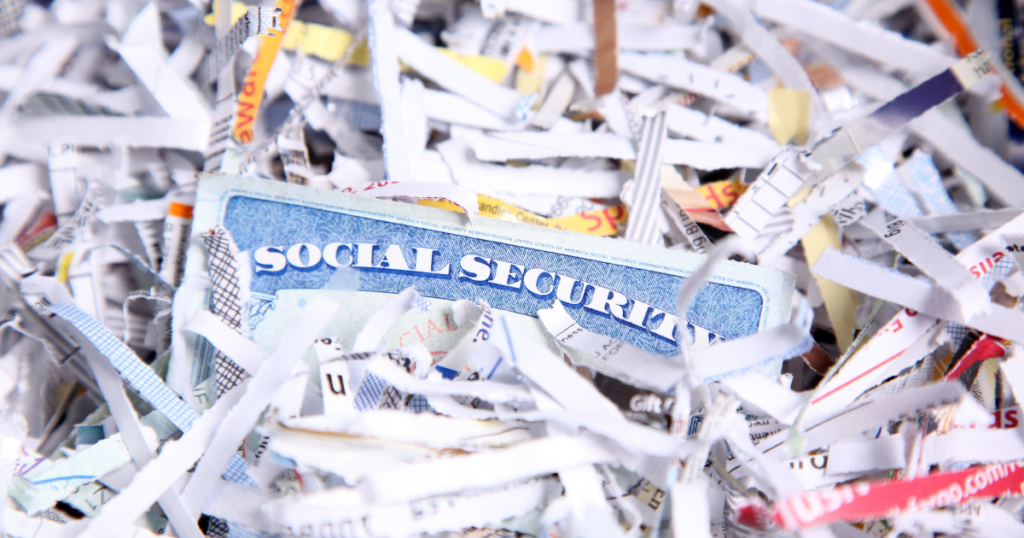As a business owner, you handle sensitive client data like phone numbers and credit card numbers. To protect your client’s information, you have to protect your own first. Identity theft can set back your business. But there are ways to minimize the risk.
How?
Keep reading! We teach you how to prevent identity theft and safeguard your business.

How To Protect Your Business from Identity Theft
Identity theft can hurt your business reputation and cause you to lose clients. It also makes your team members vulnerable. That’s why data security should be a number one priority for your business.
You can take steps to protect yourself and your business from the fallout of identity theft. Here’s how.
#1 Follow Cybersecurity Best Practices
We’re used to sharing our personal info online without a second thought. Don’t make the same mistake with your business.
Use reputable antivirus software across all of your business devices, including phones, laptops, tablets, etc. And protect your network with a firewall and a VPN. Also, only give personal data to secure websites (i.e., they begin with https). Even then, limit the number of sites that provide your data.
Remember, your business information should be on a need-to-know basis. Limit access as much as possible, even from your employees and family members. They may be more vulnerable to identity theft because they haven’t invested in business-level security.

#2 Use Strong Passwords
A strong password is the first line of defense between you and identity theft. So, avoid weak, commonly used passwords at all costs.
Ideal passwords are long, unique, and somewhat random. Don’t use words that can be linked back to your name or business. Most platforms will let you know if your password is too weak. In general, your password should be:
- Be at least eight characters, but longer is safer
- Be a passphrase instead of a password, e.g., “leashesarecool45” over “leashes45”
- Be different for each of your accounts.
- Include a mix of numbers, lowercase and uppercase letters, and special characters.
If you’re sharing a password with your team, try password manager tools like LastPass. Password managers block unauthorized entries and keep your accounts safe.
The most important password you need to keep safe is the password to your primary email. Anyone who gets access to that can say they lost their password to get access to all kinds of other accounts that you have.
Bonus Tip: Turn on Two-Factor Identification
Whenever it is available, turn on two-factor identification. It only takes an additional moment, and it’s a lot easier for a thief to get access to a password than to steal both your password and your phone. Sure, it may be a hassle, but it protects you more effectively than almost anything else.
#3 Use an EIN
If you are a sole proprietor, you can use your Social Security number for your business, but that doesn’t mean you should. Having this sensitive number in a lot more places increases your risk, while an EIN adds another layer of protection. You can get an EIN number between 7 AM and 10 PM Monday through Friday by visiting the website. And you will get your EIN in just a few minutes.
#4 Protect Yourself from Phishing
If you have ever seen a friend start to post spam on social media, they are a likely victim of phishing. Phishing is when scammers send a link by email or social media and pretend to be someone else to get you to click the link. Once you do, they will either ask you to enter sensitive information posing as another website or use malware to try and capture that information.
Here are some signs that it may be a phishing attempt.
- They ask for your login credentials
- They ask you to validate payment information
- They make time-sensitive demands
- They include attachments
- The company name and email address do not match
#5 Clean Up Your Files
It’s important to keep your files organized and up to date. Documents pile up, and identity thieves can sneak through the clutter.
Know what info is stored on your digital and physical documents. And only keep what’s absolutely necessary to run your business. Throw away or delete what you don’t need. Properly dispose of, or even destroy, old hard drives and printers that may have sensitive data.

If you keep paper records, make sure they’re secured and organized in a locked filing cabinet. Keep the key or code in a safe position and limit the number of people who have access.
As you’re cleaning up files, it’s important to make backups in case the identity thief wipes your information. Your backups should be just as secure as your regular data if not more!
#6 Check Your Credit Reports
To get ahead of identity theft, consistently monitor your bank accounts and credit reports for unusual or suspicious activity. This way, if someone steals your identity, you can catch it before it becomes unmanageable or leaves you on the hook for unauthorized charges.
Major credit reporting agencies, like Experian, have free tools and resources to help you avoid and manage business identity theft.
#7 Go As Paperless As Possible
Sure, the world has gone digital. But paper documents still hold sensitive information and may be more vulnerable than the info you store online.
For example, mail theft is alive and well. Thieves can get access to credit card accounts, insurance documents, and invoices from your mail and use them to hurt your business. You can avoid this by going paperless.
Not every business has the option to go completely paperless. And your clients might prefer a paper invoice or contract. That’s okay, switch to digital statements and communication where you can. It saves you time and money, and you get the peace of mind that your business is a bit more secure.
And remember to throw your mail through a shredder before tossing it!
#8 Get Your Team On Board
Identity theft doesn’t happen in a bubble. So, it’s important that your team members know how to protect their personal information, especially if they have access to business accounts.
As the owner, it’s your job to keep them up to date on best practices for data protection. To help your team avoid identity theft:
- Alert them of common email phishing scams before they become a victim.
- Ask them to password-protect sensitive documents that they email or edit online.
- Ask them not to download attachments before verifying the email address, even if it’s an inquiry from a potential client.
- Provide them with a business email address so they’re not handling sensitive information on a personal account.
- Set a standard for strong passwords, and require them to enable two-factor authentication on business accounts.
It’s a good idea to make identity protection training a part of the onboarding process.
#9 Have an Identity Theft Protection Plan
Identity security is all about preparation. Make sure you have a plan in place, both to prevent identity theft and handle the fallout if it occurs. Your plan will include following cybersecurity best practices with updated antivirus software and strong passwords.
So, you’ll need a response plan. If your identity is stolen, you should alert the IRS and file an FTC identity theft report.
As your business grows, security should be factored into every decision, whether you’re hiring new employees or switching booking platforms.

Protect Your Business
Identity theft leads to long-term issues for your business and your clients. You can avoid identity theft by creating a prevention plan and following data security best practices. And make sure your team is secure. A well-protected business equals happy clients.
PocketSuite can help keep your clients happy. We have all the tools you need to run your business, including booking, payments, and contracts.
As a business owner, you need to be doubly careful. After all, you need to protect your own information and the information of your clients. Business owners do not enjoy having to explain to their customers that they were hacked and their clients’ information was put at risk as a result.



